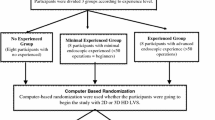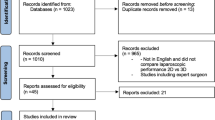Abstract
Background
High-quality three-dimensional (3D) vision systems are now available for laparoscopic surgery and may improve surgical performance relative to two-dimensional (2D) laparoscopy. It is unclear whether 3D laparoscopy is superior to 3D robotic systems. The effect of surgeon experience on surgical performance with different instruments also remains unclear. This study compared the ability of experienced and inexperienced surgeons to perform a suturing task with 2D laparoscopy, 3D laparoscopy, and a 3D robot.
Methods
The 20 recruited surgeons consisted of experts (≥100 laparoscopic cases, n = 9), surgeons with intermediate experience (20–99 cases, n = 7), and novices (<20 cases, n = 4). All performed a suturing task three times with each instrument. Task failure rates and completion times were measured.
Results
All novices failed to complete the task with 2D or 3D laparoscopy, but all completed the task with the robot. The intermediate group failed the task with 2D laparoscopy (23.8 % failure rate) more often than with 3D laparoscopy (4.8 %) or the robot (0 %; P = 0.04). Expert failure rates were low for all instruments. Intermediate group task completion times were similar to 2D laparoscopy (median 312 s; range 229–495 s), 3D laparoscopy (324 s; 170–443 s), and the robot (319 s; 213–433 s) (P = 0.237). The expert times differed significantly (P = 0.01); post hoc analyses showed that their total completion time with 3D laparoscopy (177 s; 126–217 s) was significantly shorter than with 2D laparoscopy (244 s; 155–270 s; P = 0.004). It also tended to be shorter than with the robot (233 s; 187–461 s; P = 0.027).
Conclusions
Novices benefited particularly from the robot. The intermediate group completed the task equally well and equally quickly with 3D laparoscopy and the robot. The experts completed the task equally well regardless of instrument, but their times were much faster with 3D laparoscopy. Thus, well-trained laparoscopic surgeons may not really benefit from 3D robot systems if 3D laparoscopy is available.

Similar content being viewed by others
References
Heemskerk J, Zandbergen R, Maessen JG, Greve JW, Bouvy ND (2006) Advantages of advanced laparoscopic systems. Surg Endosc 20(5):730–733
Gallagher AG, Ritter EM, Lederman AB, McClusky DA 3rd, Smith CD (2005) Video-assisted surgery represents more than a loss of three-dimensional vision. Am J Surg 189(1):76–80
Wagner OJ, Hagen M, Kurmann A, Horgan S, Candinas D, Vorburger SA (2012) Three-dimensional vision enhances task performance independently of the surgical method. Surg Endosc 26(10):2961–2968
Giulianotti PC, Coratti A, Angelini M, Sbrana F, Cecconi S, Balestracci T, Caravaglios G (2003) Robotics in general surgery: personal experience in a large community hospital. Arch Surg 138(7):777–784
Baek SJ, Lee DW, Park SS, Kim SH (2011) Current status of robot-assisted gastric surgery. World J Gastrointest Oncol 3(10):137–143
deSouza AL, Prasad LM, Park JJ, Marecik SJ, Blumetti J, Abcarian H (2010) Robotic assistance in right hemicolectomy: Is there a role? Dis Colon Rectum 53(7):1000–1006
Liu H, Lu D, Wang L, Shi G, Song H, Clarke J (2012) Robotic surgery for benign gynaecological disease. Cochrane Database Syst Rev 2:CD008978
Barbash GI, Glied SA (2010) New technology and health care costs—the case of robot-assisted surgery. N Engl J Med 363(8):701–704
Cicione A, Autorino R, Breda A, De Sio M, Damiano R, Fusco F, Greco F, Carvalho-Dias E, Mota P, Nogueira C, Pinho P, Mirone V, Correia-Pinto J, Rassweiler J, Lima E (2013) Three-dimensional vs standard laparoscopy: comparative assessment using a validated program for laparoscopic urologic skills. Urology 82(6):1444–1450
Smith R, Schwab K, Day A, Rockall T, Ballard K, Bailey M, Jourdan I (2014) Effect of passive polarizing three-dimensional displays on surgical performance for experienced laparoscopic surgeons. Br J Surg 101(11):1453–1459
Tanagho YS, Andriole GL, Paradis AG, Madison KM, Sandhu GS, Varela JE, Benway BM (2012) 2D versus 3D visualization: impact on laparoscopic proficiency using the fundamentals of laparoscopic surgery skill set. J Laparoendosc Adv Surg Tech A 22(9):865–870
Honeck P, Wendt-Nordahl G, Rassweiler J, Knoll T (2012) Three-dimensional laparoscopic imaging improves surgical performance on standardized ex-vivo laparoscopic tasks. J Endourol 26(8):1085–1088
Chandra V, Nehra D, Parent R, Woo R, Reyes R, Hernandez-Boussard T, Dutta S (2010) A comparison of laparoscopic and robotic assisted suturing performance by experts and novices. Surgery 147(6):830–839
Hubens G, Coveliers H, Balliu L, Ruppert M, Vaneerdeweg W (2003) A performance study comparing manual and robotically assisted laparoscopic surgery using the da Vinci system. Surg Endosc 17(10):1595–1599
Moorthy K, Munz Y, Dosis A, Hernandez J, Martin S, Bello F, Rockall T, Darzi A (2004) Dexterity enhancement with robotic surgery. Surg Endosc 18(5):790–795
Yamaguchi S, Yoshida D, Kenmotsu H, Yasunaga T, Konishi K, Ieiri S, Nakashima H, Tanoue K, Hashizume M (2011) Objective assessment of laparoscopic suturing skills using a motion-tracking system. Surg Endosc 25(3):771–775
Hofstad EF, Vapenstad C, Chmarra MK, Lango T, Kuhry E, Marvik R (2013) A study of psychomotor skills in minimally invasive surgery: what differentiates expert and nonexpert performance. Surg Endosc 27(3):854–863
Acknowledgments
This study was fully funded by Educational Research Grant from Olympus, Korea.
Disclosures
Young Suk Park, Aung Myint Oo, Sang-Yong Son, Dong Joon Shin, Do Hyun Jung, Sang-Hoon Ahn, Do Joong Park, and Hyung-Ho Kim have no conflict of interest to declare.
Author information
Authors and Affiliations
Corresponding author
Rights and permissions
About this article
Cite this article
Park, Y.S., Oo, A.M., Son, SY. et al. Is a robotic system really better than the three-dimensional laparoscopic system in terms of suturing performance?: comparison among operators with different levels of experience. Surg Endosc 30, 1485–1490 (2016). https://doi.org/10.1007/s00464-015-4357-9
Received:
Accepted:
Published:
Issue Date:
DOI: https://doi.org/10.1007/s00464-015-4357-9




